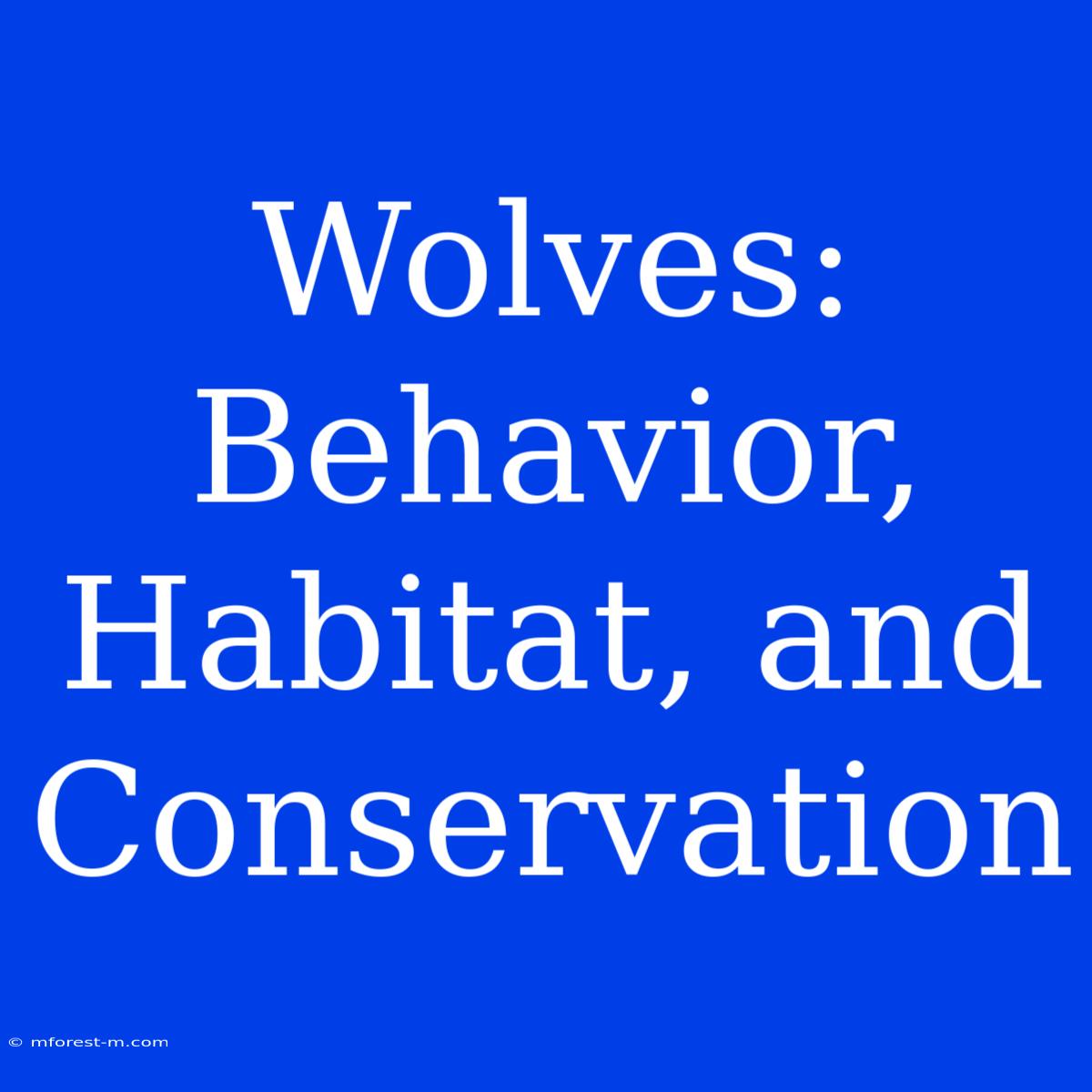Wolves: Unraveling the Secrets of the Wild
Can wolves be social and caring, or are they brutal predators? Wolves are fascinating creatures, known for their complex social structures and essential role in their ecosystems. Understanding wolf behavior, habitat, and conservation is crucial for preserving these majestic animals and maintaining healthy ecosystems.
Editor Note: This exploration of wolf behavior, habitat, and conservation has been prepared to shed light on these magnificent creatures and the vital role they play in our world.
Wolves are often misunderstood, their reputation sometimes eclipsed by fear and misinformation. This article delves into the intricacies of wolf behavior, their habitat preferences, and the pressing need for their conservation.
Analysis: To create a comprehensive guide, we analyzed extensive scientific research, expert studies, and conservation efforts to paint a complete picture of wolves, encompassing their ecological significance, social complexities, and the threats they face.
Key Takeaways about Wolves
| Aspect | Description |
|---|---|
| Social Structure | Highly complex and social, living in packs with strong hierarchies. |
| Communication | Utilize a diverse array of vocalizations and scent marking to communicate. |
| Diet and Hunting | Primarily carnivorous, preying on large ungulates like elk, deer, and bison. |
| Habitat | Thrive in a variety of habitats, including forests, tundra, and grasslands. |
| Conservation Status | Varying across the globe, with some populations threatened or endangered. |
| Ecological Role | Keystone predators that help regulate prey populations and maintain ecosystem balance. |
Wolf Behavior
Understanding wolf behavior is essential for appreciating their complex social dynamics and ecological role. Wolves are highly social animals, living in packs that can consist of 5 to 20 individuals.
Pack Structure
The pack structure is hierarchical, with an alpha male and female leading the group. These dominant wolves are responsible for breeding and maintaining order within the pack. They prioritize their offspring, with subordinate wolves often assisting in raising pups.
Communication
Wolves utilize a diverse range of vocalizations, including howls, growls, whines, and barks, to communicate with each other. Howling, particularly at night, is a crucial form of long-distance communication, allowing pack members to coordinate activities, defend their territory, and locate each other. Scent marking is another important communication method, with wolves depositing urine and feces to signal their presence and territory boundaries.
Diet and Hunting
Wolves are primarily carnivores, with a diet consisting of large ungulates such as elk, deer, bison, and moose. They are highly efficient hunters, using their keen senses and cooperative strategies to bring down their prey. Pack members coordinate their efforts, with individuals taking on specific roles such as flanking, chasing, or taking down the animal.
Wolf Habitat
Wolves thrive in a variety of habitats, as long as their basic needs for food, water, and shelter are met. Their preferred habitats include forests, tundra, grasslands, and mountainous regions. They require vast territories that provide ample prey and suitable denning areas.
Denning Sites
Wolves use dens for raising their pups and for refuge from harsh weather conditions. Dens are typically located in sheltered areas, such as caves, abandoned burrows, or thick stands of trees.
Territory
Wolves establish and defend their territories through scent marking, howling, and sometimes physical confrontations. Territory size varies depending on prey availability and habitat type.
Wolf Conservation
Conservation efforts are crucial for protecting wolf populations and ensuring their continued role in healthy ecosystems. Wolves have historically faced numerous threats, including habitat loss, persecution by humans, and disease.
Threats to Wolf Populations
Habitat loss and fragmentation due to human development pose significant threats to wolves. Persecution by humans, including hunting, trapping, and poisoning, has also played a role in declining wolf populations. Disease, particularly canine distemper virus and rabies, can also impact wolf survival.
Conservation Strategies
Conservation efforts focus on habitat protection and restoration, reducing human conflict, and promoting public awareness. Creating and managing protected areas, reducing habitat fragmentation, and promoting sustainable land management practices are essential for wolf conservation.
FAQ
Why are wolves important? Wolves are keystone predators, playing a vital role in regulating prey populations and maintaining ecosystem balance. They help to keep herbivore populations in check, which in turn prevents overgrazing and promotes biodiversity.
Are wolves dangerous to humans? While wolves are wild animals that should be respected, attacks on humans are extremely rare. Wolves are generally afraid of humans and avoid contact. However, it's important to exercise caution and maintain a safe distance from wolves in the wild.
What can I do to help wolves? Support organizations working to protect wolves and their habitats. Educate yourself and others about the importance of wolves and the threats they face. Advocate for policies that promote conservation and sustainable land management.
Tips for Observing Wolves in the Wild
- Respect their space and avoid disturbing them.
- Stay at a safe distance and never approach a wolf.
- Observe wolves from a distance using binoculars or a spotting scope.
- Be aware of your surroundings and be prepared to retreat if necessary.
- If you encounter a wolf, remain calm and avoid making sudden movements.
Conclusion
Wolves are captivating creatures that play a vital role in maintaining healthy ecosystems. Understanding their behavior, habitat preferences, and the threats they face is essential for their conservation. By promoting responsible land management, advocating for their protection, and increasing public awareness, we can ensure these magnificent creatures continue to thrive in the wild for generations to come.

